Sauna Insulation and Vapor Barriers: The Complete Guide
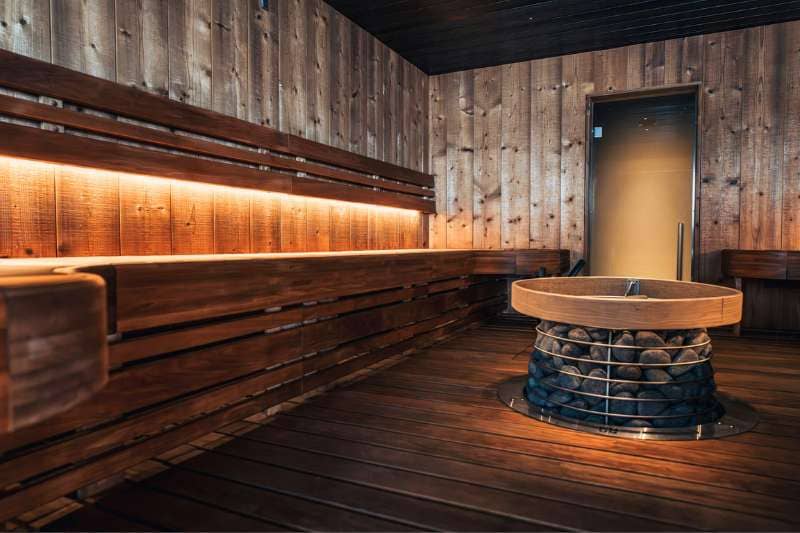
Want to make the most out of your sauna experience? Good insulation is key. It ensures efficient heat retention and saves energy.
This guide covers the basics of sauna insulation. We’ll look at why it matters, what types you can use, how to choose the right one and how to install it.
We’ll also talk about vapor barriers and why they’re important.
Whether you’re building a new sauna or fixing up an old one, understanding insulation will help you create the perfect spot to relax.
Key Takeaways
- Good insulation helps your sauna stay hot and use less energy.
- When picking insulation, think about things like R-value, how it handles moisture and fire, and how much it costs.
- You need a vapor barrier to stop moisture from building up and causing mold.
Table of Contents
What Is Sauna Insulation and Why Is It Important?
Sauna insulation is super important for making your sauna work well and feel comfy, whether it’s an indoor or an outdoor sauna.
Good insulation does a few key things:
- It keeps heat from escaping
- It helps your sauna use less energy
- It makes sure your heater (electric or wood-burning sauna heater) works efficiently
- It helps maintain the right temperature for longer
All of this means you get more health benefits from your sauna and spend less on energy bills. Plus, it makes owning a sauna more sustainable and fun.
Good insulation also stops condensation and moisture from building up, which can damage your sauna over time.
Related: Reasons your sauna is not heating up (with troubleshooting tips)
What Are the Different Types of Sauna Insulation?
Several types of sauna insulation materials are available, each with unique properties and benefits that cater to different sauna designs and heating methods.
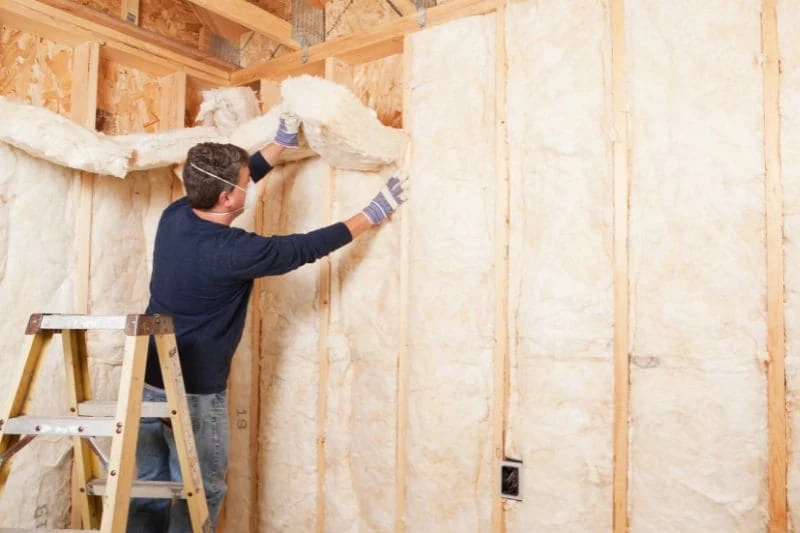
1. Fiberglass Insulation
Fiberglass is one of the most popular choice for sauna insulation. It’s cheap and works pretty well at heat retention. You’ll find it in many DIY sauna kits and professional builds.
Fiberglass traps air in its fibers, creating a barrier that stops heat from escaping. We measure how well insulation works using an R-value. The higher the R-value, the better the insulation.
Pros of fiberglass insulation:
- It’s cheap and easy to find
- It’s good at retaining heat
- It doesn’t catch fire easily
- It helps dampen sound
However, there are some downsides. It can soak up moisture, and you need to install it carefully to avoid gaps that let heat escape.
If you use fiberglass in your sauna, make sure to add a good vapor barrier and follow the manufacturer’s instructions for the best results.
2. Mineral Wool Insulation
Mineral wool is great for saunas because it handles moisture well and blocks sound. This makes it perfect for steam saunas where there’s lots of humidity.
Mineral wool is good at keeping the temperature steady in your sauna. Unlike some other materials, it doesn’t grow mold easily and stays in good shape even when it’s damp. This is really important for keeping your sauna healthy over time.
It also helps block out noise, so you can relax without distractions. And since it doesn’t burn easily, it makes your sauna safer, too.
When installed right, mineral wool can improve the efficiency of your sauna’s heating system, which can save you money on your sauna electricity bills.
Benefits of mineral wool insulation:
- Resists moisture: Stops mold from growing
- Blocks sound: Makes relaxing easier
- Resists fire: Makes your sauna safer
- Saves energy: Cuts down on heating costs
3. Foam Board Insulation
Foam board insulation works really well and doesn’t waste energy. It’s lightweight but stiff, and it’s great at heat retention. You can use it in lots of different ways when building a sauna.
Foam boards are made from stuff like polystyrene, polyisocyanurate, or polyurethane.
It’s pretty easy to install, too, typically involving the following steps:
- Measure your sauna space carefully.
- Cut the foam boards so they fit snugly on the walls, ceiling, and floor.
- Stick the boards in place with glue or nails.
- Use tape or caulk to seal the edges so air can’t leak out.
When you use this kind of insulation, your sauna retains heat better. This means it uses less energy, which is good for the planet and your wallet. It’s a smart way to enjoy all the good stuff saunas do for your health.
4. Reflective Foil Insulation
Reflective foil insulation is a special kind. It works by reflecting radiant heat back into the sauna. This helps with heat retention and saves energy. It also acts like a vapor barrier.
This cool insulation does more than just basic heat protection. It helps keep the perfect balance in your sauna environment.
By reflecting radiant heat, this insulation can make your sauna comfy without using as much energy. That’s great if you want to save on bills. It also stops moisture from building up, which can cause mold and damage over time.
Good things about reflective foil insulation:
- Works in all saunas: You can use it in old-school wood-burning saunas or new infrared ones.
- Easy to put in: You don’t need fancy tools or lots of know-how to install it.
- Saves energy: Because it retains heat so well, you might see your energy bills go down.
When you think about all these benefits, you can see how reflective foil insulation can make your sauna work better and be more enjoyable.
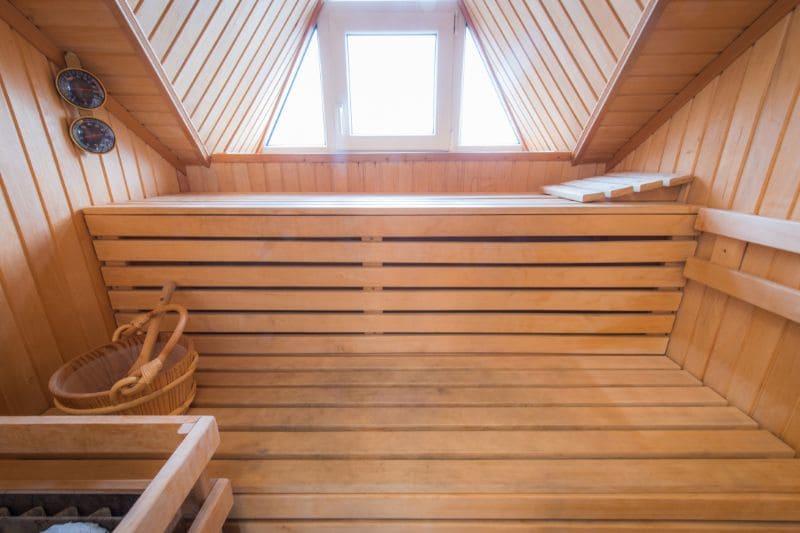
5. Natural Fiber Insulation
If you care about the environment, you might want to check out natural fiber insulation for your sauna. Materials like hemp and cellulose work great. They offer great thermal performance and handle moisture nicely.
These materials help trap warmth but also let air move around. This means your sauna stays healthier inside.
Using wood with natural fiber insulation not only looks good, but it also lasts a long time and is good for the planet. By picking these natural materials, you’re helping the environment and making your wellness routine more eco-friendly.
Take hemp, for example. It’s really good at dealing with moisture. This helps control how humid your sauna gets, which stops mold and keeps things just right for a great sauna session.
Cellulose, which is made from recycled paper, is also awesome. It provides excellent thermal insulation and prevents air from leaking out.
This mix of materials helps your sauna use less energy and creates a warm, cozy feeling that makes relaxing even better. So you can enjoy your sauna while also making smart choices for the planet.
What Are the Factors to Consider When Choosing Sauna Insulation?
When picking insulation for your sauna, there are a few important things to consider. These include the R-value, how well it handles moisture, if it’s fire-resistant, and how much it costs. All of these things affect how well your sauna works and how safe it is.
1. R-Value
The R-value of insulation is a measure of its thermal resistance. It’s super important to figure out how well sauna insulation holds onto heat and uses less energy.
If you’re building or fixing up a sauna, you need to understand the R-value. It has a big impact on how well your sauna works and how comfy it is.
Different insulation materials, like fiberglass or foam boards, have different R-values. These numbers show how well they work. You can find these numbers on the product info or by comparing different types.
Higher R-values mean the insulation works better. This means less heat escapes, and your sauna performs better. In the long run, this means lower energy bills, more steady temperatures, and a better sauna experience.
So, choosing insulation based on R-value can really improve your sauna experience.
2. Moisture Resistance
How well insulation handles moisture is really important, especially in steam saunas where there’s lots of water in the air. If the insulation can’t deal with moisture, it can get damaged, and your sauna won’t last as long.
If you don’t address moisture problems, mold might grow, and your insulation might start to fall apart, which ultimately affects the sauna’s performance. It’s a good idea to use materials that don’t soak up water, like fiberglass or foam boards.
In the end, a sauna with good insulation that can handle moisture will last longer and be more fun to use.
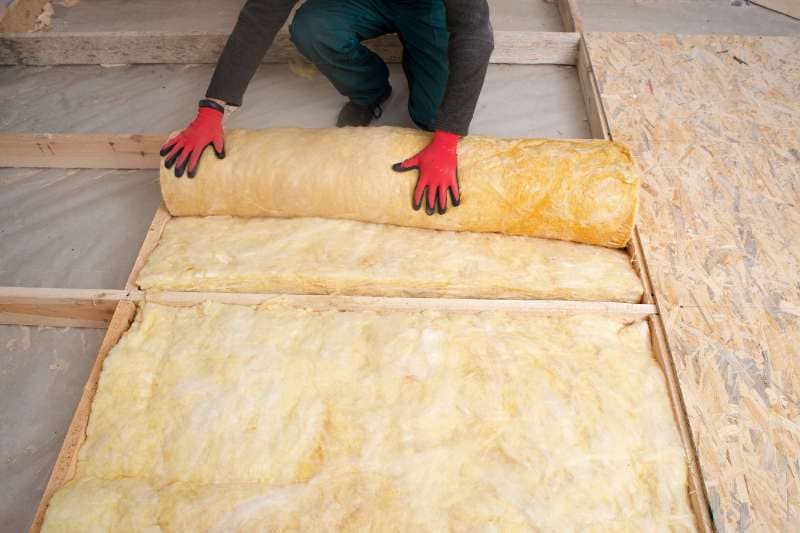
3. Fire Resistance
Another big deal when picking sauna insulation is how well it resists fire. This helps keep you safe if your sauna heater gets too hot or something goes wrong.
When you’re looking at insulation options, check out their fire resistance ratings. These ratings tell you how safe different materials are.
Here’s a quick look at some common insulation materials and how fire-resistant they are:
- Mineral Wool: Doesn’t burn and is great at handling heat.
- Fiberglass: Can handle heat well but should have a fire-resistant cover.
- Foamed Cement: A good choice because it resists both fire and moisture.
By picking insulation that’s good at resisting fire, you can make your sauna a lot safer and create a better place to relax.
Also Read: Fire Safety and Prevention in Saunas
4. Cost
Cost is always a significant factor when choosing sauna insulation. It influences the overall budget for sauna construction or renovation, impacting not just the initial investment but also long-term energy efficiency and maintenance expenses.
When you’re considering insulation options, try to strike a good balance between quality and cost. It might be tempting to buy the cheapest stuff, but that could mean you use more energy and have to replace it sooner.
Think about options like mineral wool, which works well and isn’t too expensive, or rigid foam boards that insulate really well for a good price. Spray Foam costs more at first but can save you a lot on heating bills over time.
In the end, making smart choices about insulation materials will help your sauna work better and last longer, giving you a comfy experience while keeping costs under control.
How to Insulate a Sauna?
Insulating a sauna involves several steps to ensure that the sauna walls, ceiling, and floors are adequately protected from heat loss and moisture, which can negatively impact the sauna’s performance and user experience.
1. Preparing the Sauna Space
Preparing the sauna space is a critical first step in the insulation process. You need to make sure the area is clean and ready for insulation boards and that there’s good airflow.
To create the best sauna environment, start by cleaning the sauna thoroughly. Get rid of any dust or junk that could damage the insulation.
It’s super important to check for moisture because dampness can cause mold and make the insulation not work that well. Use a moisture meter to check the wood and surrounding areas.
Also, good airflow is a must. It helps control the sauna’s humidity and ensures its proper operation.
- Make sure the ventilation fans are working right.
- Think about putting vents near the floor and ceiling.
- Look for any leaks that could mess up the airflow.
By following these steps, you can create a nice atmosphere that’s great for relaxing and feeling refreshed.
Also Read: Sauna Ventilation

2. Choosing the Right Insulation Material
Choosing the right insulation for your sauna is super important for achieving optimal heat retention and energy efficiency. You’ve got options like fiberglass, mineral wool, and foam board, and each one has its own good points.
When you’re looking at these materials, there are a few important things to think about:
- R-value: Pick materials with high ratings for optimal heat retention.
- Moisture Resistance: Look for options that work well in really humid places.
- Cost: Try to balance your budget with how long the insulation will last and how much energy it’ll save.
If you think about these things, you’ll pick insulation that works great for what your sauna needs.
3. Installing the Insulation
When you’re putting insulation in a sauna, you need to be really careful. You have to put the insulation boards in the right place, make sure there’s a vapor barrier, and seal any gaps so heat doesn’t escape.
A good insulation job will not only enhance your sauna experience but also contribute to energy savings in the long run.
First, make sure the sauna walls are clean and dry before you put in the insulation boards. Rigid foam or fiberglass insulation are good choices because they provide excellent thermal resistance.
When you’re putting the boards in, make sure they fit snugly against the walls and ceiling. If there are gaps, the insulation won’t work as well.
Next, putting in the vapor barrier is really important. This layer should go on the warm side of the insulation to trap heat and moisture. Carefully tape the edges of the vapor barrier to stop air from leaking.
- Use caulk around windows and doors to stop drafts.
- Double-check for any small openings to make sure everything is sealed up.
If you follow these steps carefully, your sauna will use less energy and be more comfortable for everyone.
What Is a Vapor Barrier and Why Is It Important in Sauna Insulation?
A vapor barrier is a really important part of sauna insulation.
In a sauna, you put the insulation in first to keep the heat in. Then you put the vapor barrier over the insulation to protect it from moisture and steam. This helps the insulation work better and last longer, and it keeps your sauna in good shape.
How Does a Vapor Barrier Work?
A vapor barrier stops moisture from getting through the walls and ceiling of the sauna. This helps control how humid it is and stops water from collecting on surfaces.
These barriers are usually made from stuff like polyethylene or foil that water can’t get through.
When properly installed, they create a protective shield that stops extra water vapor from damaging your sauna.
This is important because, without a vapor barrier, humidity can make mold grow, rot the wood, and make your sauna use more energy. This can make your sauna experience not as good.

Types of Vapor Barriers
There are a few different types of vapor barriers you can use, like foil vapor barriers and polyethylene sheeting. Each one protects against moisture differently and works better with different kinds of insulation.
Here’s a quick look at the most common types:
- Foil Vapor Barriers: These are often used in saunas because they reflect heat and moisture very well, creating a tight seal. This, in turn, can help keep the sauna warm.
- Polyethylene Sheeting: This is a cheaper option that’s common in regular construction. It’s good at stopping moisture, but it might not help with heat as much as foil does.
- Smart Vapor Barriers: These newer products adjust their permeability based on humidity levels, making them versatile for changing conditions. They’re becoming more popular for modern saunas.
When you’re picking a vapor barrier, consider its lifespan, cost, and your specific sauna needs.
Foil barriers are often the best choice because they work well in hot, humid conditions.
What Are the Steps for Installing a Vapor Barrier in a Sauna?
Installing a vapor barrier in a sauna involves a few key steps to make sure moisture is controlled properly. You start by picking the right type of barrier and end by securing it against the insulation and walls.
It’s really important to understand this process because it directly affects how well your sauna works and how long it lasts. Here’s a quick guide on what to do:
- Check out your sauna: Figure out how much moisture and heat it’ll be exposed to so you can pick a barrier that can handle it.
- Choose the right vapor barrier: People often use polyethylene sheets or special vapor retarders because they work well.
- Measure and cut: Carefully measure the walls and ceiling of your sauna before cutting the vapor barrier to fit snugly.
- Secure the barrier: Use staples or glue to attach the barrier firmly to walls or insulation. Make sure there are no gaps that could let moisture escape.
- Look for leaks: Once it’s installed, check all the seams and edges to make sure there aren’t any potential leaks that could make the barrier not work as well.
Following these steps will not only make your sauna experience better but also make your sauna last longer.
Common Mistakes to Avoid
In terms of sauna insulation, avoiding common mistakes is key to getting the best performance and longevity out of your sauna.
You might overlook the importance of choosing the right materials, forget to add proper vapor barriers, or not calculate the necessary R-value for your insulation. By steering clear of these pitfalls, you can boost the efficiency and comfort of your sauna while reducing the risk of moisture damage and heat loss.
Improper sealing can create significant air leaks, which not only mess with your sauna’s ability to hold onto that precious heat but can also turn it into a cozy home for mold and mildew.
If you pick the wrong insulation materials, you might face thermal bridging, which means heat escapes and your energy efficiency takes a hit.
It’s super important to do your homework before diving into the installation process. Consider consulting professionals who know their way around sauna construction.
Prioritizing these elements will not only improve your sauna experience but also help you enjoy the long-term health benefits that come with regular sauna use.
Conclusion
Sauna insulation is a critical component that directly influences the performance, efficiency, and overall enjoyment of using a sauna, underscoring the necessity for proper insulation techniques and materials.
By ensuring that the sauna is well-insulated, individuals can effectively maintain the desired temperature, reduce energy costs, and enhance their overall experience.
Proper insulation minimizes heat loss, which is essential for achieving the ideal environment needed for relaxation and health benefits.
A well-insulated sauna aids in dampening sound and creating an intimate atmosphere, which is essential for a personal retreat.
Thus, investing in quality sauna insulation is fundamental not just for hygiene and safety but also for maximizing the rejuvenating effects of sauna therapy.
FAQs About “Sauna Insulation”
Can I install sauna insulation myself, or do I need a professional?
While you can install sauna insulation yourself, it’s usually better to hire a pro for the best results. They know what they’re doing and have the right tools to install the insulation properly and safely.
How does sauna insulation impact energy efficiency?
When sauna insulation is installed correctly, it can really improve energy efficiency by keeping the heat inside the sauna. This means your sauna will heat up faster and use less energy to stay at the right temperature. This saves you money and is better for the environment.
Are there any specific considerations for sauna insulation in outdoor saunas?
Yes, when you’re insulating an outdoor sauna, you need to choose materials that can handle moisture and weather. It’s also really important to seal any gaps or cracks in the insulation to stop heat from escaping. And using a vapor barrier is crucial to protect the sauna from moisture in outdoor environments.

“Become a Sauna Expert Overnight!”
Grab Your “FREE” Sauna E-book NOW!
Get your hands on the ultimate sauna manual. From history to DIY setups, our free guide has it all.

As a Chartered Accountant turned sauna enthusiast, I bring a unique blend of analytical skills and hands-on experience to the world of heat therapy. With over a decade dedicated to researching and testing sauna products and practices, I’ve developed a deep understanding of this field. A the founder of HomeInDepth.com, I provide reliable, easy-to-understand information on all aspects of saunas. My goal is to guide you through every step of your sauna journey, offering meticulously researched, unbiased advice to help you make informed decisions and create your perfect sauna experience. I’m always happy to hear from sauna lovers like you—feel free to leave questions or share your own tips in the comments below so we can learn together. Contact me on:




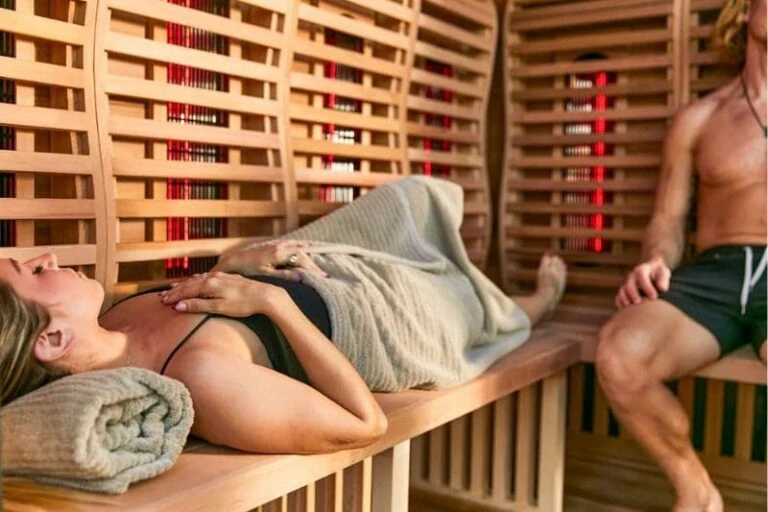
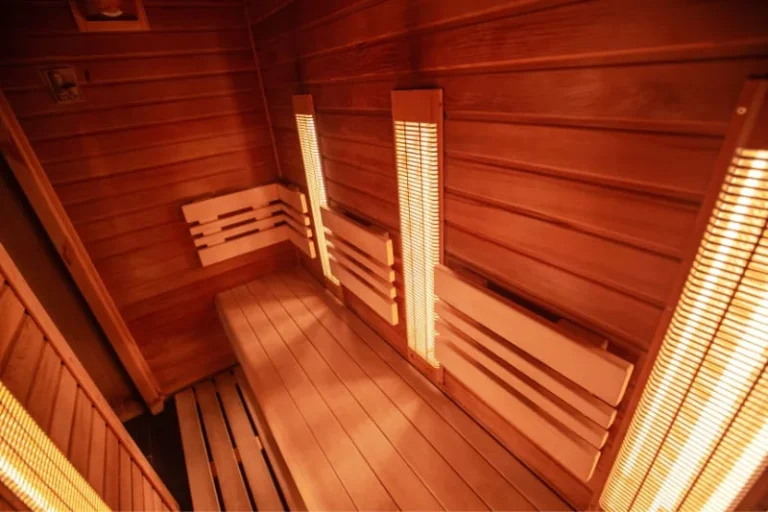

3 Comments